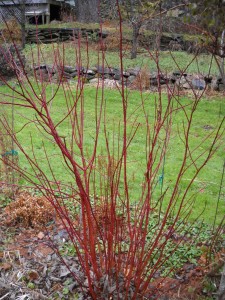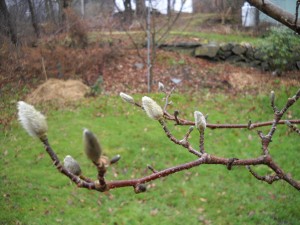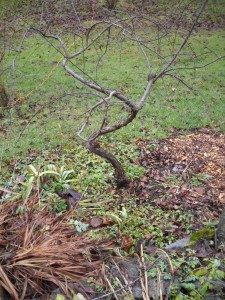The Winter Landscape
My friend and neighbor, Connie Kousman, is one of the few people I know who likes swamps. She is an avid kayaker who collects cranberries and other plants that do well in wet areas – swamps, ponds and lakes. I called her recently to see if she knew where I could pick some winterberry (Ilex verticillata) for use in vases and on my wreath. I grow winterberry, but this year I didn’t get any of those bright red berries I like so much for decoration. No, Connie allowed that this was a bad year for winterberries – and wild cranberries, too. Some years are like that.
This prompted me to walk around my property looking at my woody shrubs to see what might substitute for winterberries. I didn’t find any berries at all. But I did cut some red-twigged dogwood (Cornus sericea) to use in a vase, and some budded branches of a Merrill magnolia (Magnolia x loebneri). The magnolia buds are a bit like pussywillows on steroids: an inch long and very fuzzy. I have some in a vase on the table, and they look very good, and will for many weeks ahead. I cut some greenery to go with them, a few stems of juniper.
Recently it struck me that winter can be pretty bleak for people who don’t have nice looking winter shrubs and trees. And that judicious pruning can turn a cluster of small river birch, for example, from something akin to an unmade bed into lovely focal point. The trick? Cut off small lower branches that are just clutter, and that can never develop into handsome thick branches. When pruning, I ask myself, what will this little branch, currently the thickness of a finger, look like when it is the thickness of an arm – or a leg. If it is growing sideways toward a walkway, it must come off.
But back to woody plants that look good in winter. Bark is important. I like plants that have exfoliating bark, which means bark that is shaggy and peeling off – thus showing more than one color. My Seven sons Flower Tree (Heptacodium miconioides) is one of those. In addition to the nice bark it offers me a display of small white flowers each fall. White birch (Betula papyrifera) and river birch (Betula nigra) are others with interesting bark. In fact all the birches have handsome bark.
I’ve been growing a paperbark maple (Acer griseum) for about 10 years. It has lovely shaggy reddish-brown bark that is very handsome. It is a very slow-growing tree, at least in this climate. It is listed as a Zone 5 plant (good to minus 20 F) but mine has survived colder temperatures. It looks great in winter.
One of my favorites – but one I do not grow – is sycamore (Platanus occidentalis), which I knew growing up in Connecticut but is rare in New Hampshire where I live. It reminds me of the English plane tree, so common in Europe. The bark peels off in big swaths, showing light gray-green in some areas, dark brown in others.
Of the bigger trees, I like American beech (Fagus sylvatica) for its smooth gray bark. Unfortunately, beeches are prone to a fungal disease that mars the bark and eventually kills the tree.
That same smooth bark is a prominent feature of a shrub known variously as shad bush, serviceberry and Saskatoon bush. All belong to the genus Amelanchier but bear different species names. Most are multi-stemmed bushes that get no more than 10 feet tall, though I have a wild one more than twice that height. You may have noticed that wild ones alongside the road – they are understory plants that are one of the first shrubs to bloom in the spring. Their blossoms are similar to apple blossoms. They do well in partial sun.
Apple trees, particularly crabapples, can look great in winter. Some crabs hold onto their fruit throughout much of the winter, some drop their fruit in fall and many provide fruit for the birds to eat (that disappears before winter is done). Ask at the nursery when you buy a crabapple if the birds like the fruit.
I have a “curly” crabapple, one that was trained at the nursery to have leader that curls around in a gentle swoop. Instead of growing tall, it has been trained to grow in a rough corkscrew. Mine has weeping branches, most of which aim towards the ground, and although I’ve lost track of its name, better nurseries should have it. I got mine at E.C. Brown’s Nursery in Thetford, Vermont.
Last but least are the broad-leafed evergreens: rhododendrons, azaleas and mountain laurels. Their leaves don’t drop off and can look handsome in winter against the snow. The leaves can dry out on sunny days and get very wrinkled, but that does not damage the plants. You can minimize this effect by spraying them with a waxy product known as Wilt-Pruf.
So if your landscape has little to offer you in winter, plan on adding some winter interest come planting time. And if your trees and shrubs are drab, think about adding some strings of little winter lights to brighten them up, at least at night.
Read about Henry’s new children’s book at www.henryhomeyer.com. Write him at P.O. Box 364, Cornish Flat, NH 03746 or e-mail him at henry.homeyer@comcast.net. He is always pleased to hear from you.





